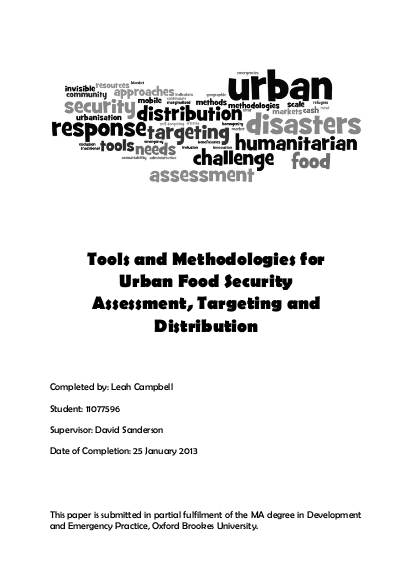
While interest and awareness of urban disasters is growing, recent humanitarian emergencies such as the 2010 Haiti earthquake show that urban-specific tools and methodologies are not consistently being used. This paper addresses the topic by asking whether existing tools and approaches are suitable for assessment, targeting and distribution in urban humanitarian response to food insecurity? The paper is based on a literature review as well as the author’s experiences working with ALNAP to create the Urban Humanitarian Response Portal.
Urbanisation worldwide is growing and diversifying. No longer a dichotomy, urban and rural areas are best understood as existing on a continuum. While food insecurity traditionally has been seen as a rural problem, recent events have highlighted the relevance of this emergency for urban environments, so approaches must adapt in order to be effective. Disaster response tools are also mostly urban-specific, however the high likelihood of more mass-scale urban disasters in the near future mean humanitarians must be prepared. Urban disasters are unique for a great number of reasons, including but not limited to scale, heterogeneity, chronic vulnerabilities, the challenges of slum areas and marginalised populations, new actors and community associations, dense and diverse populations. Traditional approaches to assessment are not suitable for urban response as these methods are time and resource intensive and can’t be scaled up to match the size of urban areas. The different communities, food sources and consumption, livelihoods and expenditures found in urban contexts all require adjustments for assessment tools and methodologies. While traditional assessments are unsuitable, there are several guides to assessment in urban contexts available, which need to be more consistently relied on in future urban food security response.
Traditional approaches to targeting the food insecure require adjustment to meet the needs of the urban context. Relevant urban features include the population’s heterogeneity, lack of baseline data, a dense population with vulnerable individuals spread out, different understandings of households and community and many actors who seek to influence the targeting approach. These all present challenges for targeting method and there is no one-size-fits-all solution. Despite these difficulties, targeting is extremely important and should not be rushed or ignored.
Distribution for food security response has historically been in the form of physical food aid delivered through relief committees in mass dispersals of goods. Urban environments require a dramatic shift, and lots of work is being done on new distribution approaches These include cash programming, remote and mobile methods, and partnering with traders and financial institutions to deliver aid without disrupting urban markets.
In conclusion, while urban disasters present many challenges, there are ways to adapt and new methods and guidelines already in existence. Humanitarians must recognise the need for urban-specific assessment, targeting and distribution but don't need to reinvent the wheel for each new programme. Instead, they should take advantage of existing knowledge and continue to build upon these approaches in order to respond most effectively to urban disasters in the future.
Links
Resource collections
- Accountability to affected populations (AAP)
- Evaluating humanitarian action
- Monitoring and Evaluation (M&E)
- Monitoring of humanitarian action
- UN Habitat - Urban Response Collection
- Urban Response - Urban Crisis Preparedness and Risk Reduction
- Urban Response Collection - Community Engagement and Social Cohesion
- Urban Response Collection - Economic Recovery
- Urban Response Collection - Environment and Climate Change
- Urban Response Collection - Housing, Land and Property
- Urban Response Collection - Urban Crisis Response, Recovery and Reconstruction
- Urban Response Collection - Urban Resilience
- Use of evaluation evidence